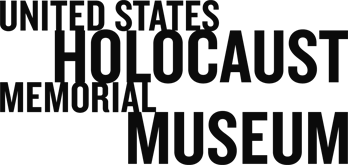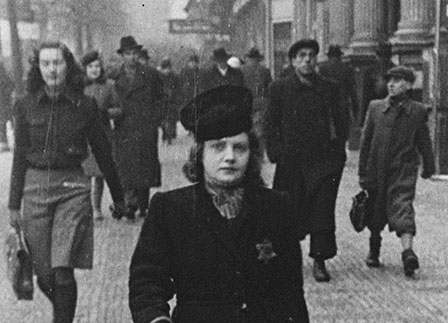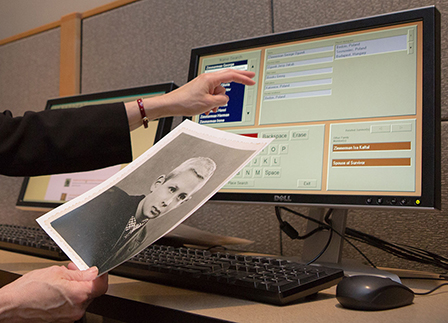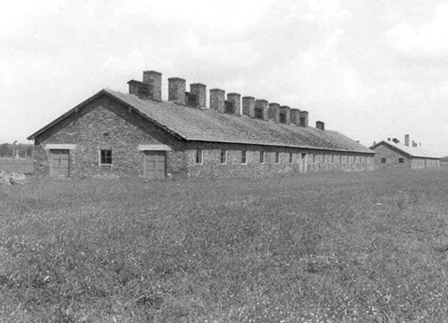Overview
- Description
- Consists of photocopies of photographs taken during April and May of 1945 of the Bergen-Belsen concentration camp shortly after liberation by the 2nd British Army. Included are photos of camp survivors, burial of dead prisoners by the SS guards of the camp, the burning of several barracks by the British, and several groups of women in the camp.
- Collection Creator
- Hadassah Rosensaft
- Biography
-
Hadassah Bimko (later Rosensaft) was born on August 26, 1912, in Sosnowiec, Poland. In 1935, Hadassah received her doctorate in dental surgery and began a career as a dentist. In September 1939, she was living with her family in Sosnowiec, Poland, when Nazi Germany invaded and occupied the country. In 1943, Hadassah, her 5.5 year old son, and her parents were sent to Auschwitz concentration camp. Her son and parents were soon killed on the gas chambers. Hadassah was made to work as a doctor in the infirmary. Aware that sick inmates often were sent to the gas chambers to be killed, Dr. Rosensaft sent them out of the infirmary and told camp officials that they were healthy. She remained a prisoner in Auschwitz until November 14, 1944, when she was sent to Bergen-Belsen concentration camp in Germany. She again was told to work as a doctor. In December 1944, 101 Jewish orphans arrived at the camp and were placed in her care. Bergen Belsen was liberated on April 15,1945, by British forces. Hadassah is credited with helping save hundreds of Jewish inmates at Auschwitz. She testified at the 1945 war crimes trial of former commandants and staff members from Auschwitz and Bergen-Belsen. She identified 15 of the 45 mass murder defendants, including Josef Kramer, a former commandant known as "the Beast of Belsen." Her family soon died in the gas chambers, and she went to work in the infirmary. The war ended when Germany surrendered on May 7. Soon after this, Hadassah married Joseph Rosensaft, who was chairman of the Jewish Committee of Bergen-Belsen, which oversaw the needs of camp survivors. Dr. Rosensaft, 85, died on October 3, 1997.
Physical Details
- Extent
-
2 folders
- System of Arrangement
- Arrangement is thematic
Rights & Restrictions
- Conditions on Access
- There are no known restrictions on access to this material.
- Conditions on Use
- The donor, source institution, or a third party has asserted copyright over some or all of these material(s). The Museum does not own the copyright for the material and does not have authority to authorize use. For permission, please contact the rights holder(s).
Keywords & Subjects
Administrative Notes
- Holder of Originals
-
Photographic Reference Collection United States Holocaust Memorial Museum - Curatorial Affairs Department
- Legal Status
- Permanent Collection
- Provenance
- The materials were collected by Hadassah and Josef Rosensaft through the years since their liberation from Bergen-Belsen. The photographs and photograph negatives (formerly belonging to the Rosensaft family archives) were copied by the accessioning archivist and the originals transferred to the United States Holocaust Memorial Museum Photo Archives.
- Record last modified:
- 2023-08-25 08:35:32
- This page:
- https://collections.ushmm.org/search/catalog/irn502679
Download & Licensing
- In Copyright
- Terms of Use
- This record is not digitized and cannot be downloaded online.
In-Person Research
- Request 7 Days in Advance of Visit
- Plan a Research Visit
-
Request in Shapell Center Reading Room
Bowie, MD
Contact Us
Also in Bergen-Belsen related records
Hadassah Rosensaft photograph collection
Document
The papers consist of one photograph of Benjamin Bimko-Preizerowicz, son of Hadassah Bimko-Rosensaft [donor] and Josef Preizerowicz, who was born in Sosnowiec, Poland, on December 3, 1937 and died at Auschwitz-Birkenau on August 4, 1943. The papers also include a photograph of a group of Jewish men with raised hands that was taken in Będzin, Poland, in September 1939.
Emigration of Jewish displaced persons to Palestine
Document
Consists of copies of reports and memoranda relating to the emigration of Jewish displaced persons from the British Zone in Germany to Palestine. Included is information about the emigration of orphans during operation "Grand National Junior," the emigration of Jewish displaced persons during operation "Journey's End," emigration restrictions on Jewish men of military age, and the acquisition of exit permits for the British Zone and entry visas for Palestine.
Evacuation of the Hohne camp and Glyn Hughes hospital
Document
Includes letters, memoranda, and minutes of meetings written between November 1949 and May 1950 relating to the evacuation of Jewish displaced persons from the Hohne camp near Bergen-Belsen and the Glyn Hughes hospital. Also included is a July 16, 1948, memorandum written by Josef Rosensaft concerning the growth of antisemitism in the British zone of Germany.
Bergen-Belsen memorial planning information
Document
Consists of planning notes, memoranda, and other materials relating to the establishment of the Bergen-Belsen memorial and cemetery. Included is information about inscriptions for the memorial, translation of inscriptions, the dedication ceremony for the memorial, and the maintenance of the memorial site.
The United States Holocaust Memorial Commission and United States Holocaust Memorial Council
Document
Contains information about the establishment of the President's Commission on the Holocaust by President Jimmy Carter in 1978 and the establishment of the United States Holocaust Council in October 1979.
Scrapbook
Document
Includes information about the liberation of Bergen-Belsen concentration camp, the outbreak of disease at the time of liberation, Josef Kramer and SS guards at the camp, the United Jewish Appeal Conference in Atlantic City, N.J., in December 1945, and the establishment of the Bergen-Belsen liberation memorial.
Seizure of the S. S. Dromit cargo
Document
Consists of letters and other documents (some originals and some photocopies) relating to the seizure of foodstuffs and Jewish possessions from the S. S. Dromit in 1949. Included among the documents is a German-language "statement of witness" submitted to the British Civil Police Unit in November 1949 by Josef Rosensaft.
Personal papers of Hadassah and Josef Rosensaft relating to displaced persons activities and Bergen-Belsen
Document
Includes information about the emigration of Jewish orphans to Israel, the administration of the Bergen-Belsen displaced persons camp by the British Army, the 1946 Vaad Leumi Session in Israel concerning Jewish refugees of the Holocaust, food rationing in the Hohne displaced persons camp, military activities of the Haganah in Israel circa 1946, the April 1948 protest by Bergen-Belsen displaced persons against world indifference toward their situation, and the activities of Hadassah and Josef Rosensaft in relation to the Central Jewish Committee of the British Zone and the emigration of Jewish children.
Bergen-Belsen
Document
Contains information about the establishment of health care facilities after liberation, the activities of Hadassah and Josef Rosensaft as leaders in the Bergen-Belsen displaced persons camp, and the closing of the camp in 1950.
Articles relating to the war crimes trial of Bergen-Belsen guards
Document
Consists of photocopies of newspaper articles relating to the September 1945 war crimes trial of several Bergen-Belsen guards. Included is information about the testimony of Dr. Ada Bimko (a.k.a.Hadassah Rosensaft), selections for the gas chambers at Auschwitz, results of medical experiments on female prisoners, and atrocities committed by the SS guards at Bergen-Belsen.
Scrapbook
Document
Includes information about the work of Josef Rosensaft with the displaced persons of Bergen-Belsen, the final days and closing of the Bergen-Belsen concentration camp, compensation for Jews who were detained in the camp after liberation, and antisemitism experienced by Jews remaining in the British Zone after liberation.
Undzer hurbm in bild
Document
Consists of an original copy of "Our destruction in pictures," collected and edited by Rafael Olevski, Dawid Rosental, and Paul Trepman and copyrighted in December 1946. The book contains photographs depicting scenes of Jewish persecution, ghettos, starvation, forced labor, concentration camps, liberation, and partisan resistance.
Letters of congratulations for Hadassah Rosensaft on her eightieth birthday
Document
Contains copies of letters of congratulations for Hadassah Rosensaft on the occasion of her 80th birthday from President George Bush; David Dinkins, mayor of New York City; Chaim Herzog, president of Israel; and Teddy Kollek, mayor of Jerusalem.



